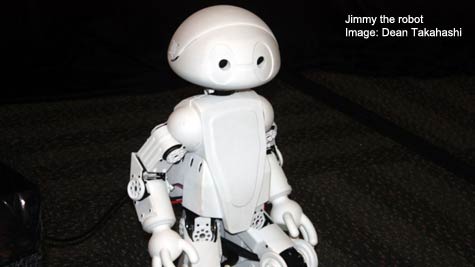In the late 1970s, we had computers that we could work with in schools and businesses, but the idea of a computer in our homes or one that could provide for our personal needs, outside of increasingly portable calculators, was off into the future. Then two kids, Steve Jobs and Steve Wozniak, created the Apple I, a computer kit that actually did something other than flash cryptic lights, and that was the true birth of the personal PC.
Now we have robots that we can see in industrial settings or work with in large universities, but outside of robotic vacuums that are increasingly capable, we are waiting for an Apple-type event.
At Intel, Brian David Johnson is trying to be both Jobs and Wozniak, creating Intel’s version of the Apple I, but for robotics: a robot called Jimmy. I see a similar evolution story unfolding.
Building an Ecosystem
What needed to happen to move computers from expensive calculators, science experiments and huge dedicated machines that could only be afforded commercially to what we now have in PCs, tablets and smartphones was an ecosystem that could scale. You need an industry to create the volume to drive technology like this into affordable personal forms.
What we didn’t have in the 1970s and 1980s was 3D printing, which increasingly brings the cost of rapid prototyping into a price range that would allow it to be placed in garages and homes, not just factories.
The other part is software. Part of the presentation at IDF was by a university intern who created a program for Jimmy that allows the robot to actively sample air quality and report verbally the problems it finds. The use would be to assure that a child near the robot wasn’t placed in a space that could cause cancer or other health problems. You see, to create a technology wave, you need to get young people excited about the future of robotics and creating the future they envision. Apple wasn’t created by old folks but by kids. Kids also represent the future of affordable robotics.
The IT Problem
Why am I even talking about this in an IT-focused publication? Think back: When PCs took off, IT was caught napping. In IBM, I was part of two major efforts to use PCs to make IT obsolete. The divisions I worked for basically pulled the plug on most IT services, forcing a lot of very painful changes to our central and suddenly redundant IT departments.
While robotics likely doesn’t represent the same near-term threat to IT, it does represent an area that should be in IT but likely won’t be — unless IT is ready to offer help when the trend takes off. Securing and assuring that the right robots are selected and implemented should be part of IT’s charter, but this won’t happen unless IT already has the skills.
IT needs to start learning about robots like Jimmy to get up to speed on how this technology can be implemented safely and successfully. Rather than reducing the utility of IT, with preparation, robotic skills should allow IT to add value. Rather than creating downsizing, this would instead force specialized hiring. Employees who have knowledge of robotics should become far more valuable.
Wrapping Up: Jimmy Isn’t Just for Kids
While Jimmy was created initially for kids, the platform is actually already evolving to be a training platform for everyone. There are two versions: one at $1,600, which really is more focused on kids, and one at $16,000, for folks like us who need a more industrial-grade solution. The Apple I wasn’t just for kids and neither is Jimmy. Consider at least monitoring this effort, if not embracing it, so when robots go vertical you have the skills to ride this wave and not be hit by it.
We are watching the birth of robotics. Robots are designed to replace people, making it a very different risk than PCs ever were. Put a different way, the next Apple will likely be connected to a robotics product. Catching that wave early could be incredibly lucrative, missing it just as incredibly painful.
Rob Enderle is President and Principal Analyst of the Enderle Group, a forward-looking emerging technology advisory firm. With over 30 years’ experience in emerging technologies, he has provided regional and global companies with guidance in how to better target customer needs; create new business opportunities; anticipate technology changes; select vendors and products; and present their products in the best possible light. Rob covers the technology industry broadly. Before founding the Enderle Group, Rob was the Senior Research Fellow for Forrester Research and the Giga Information Group, and held senior positions at IBM and ROLM. Follow Rob on Twitter @enderle, on Facebook and on Google+




